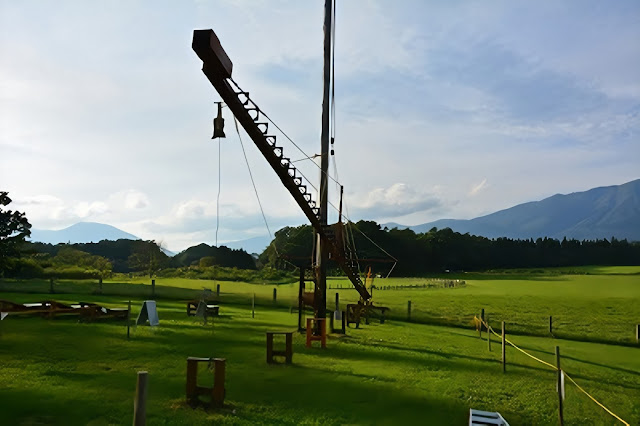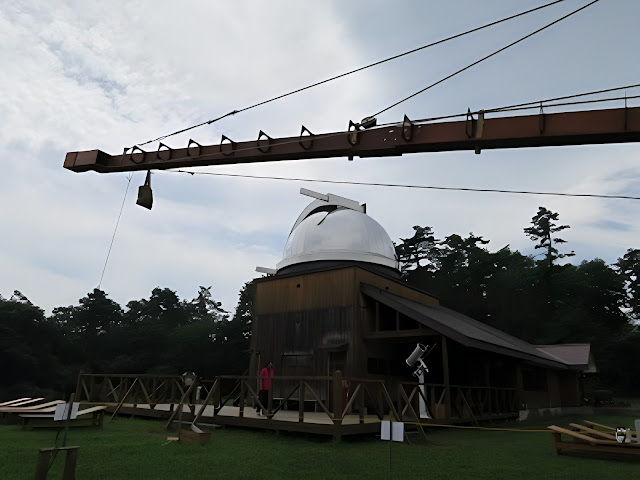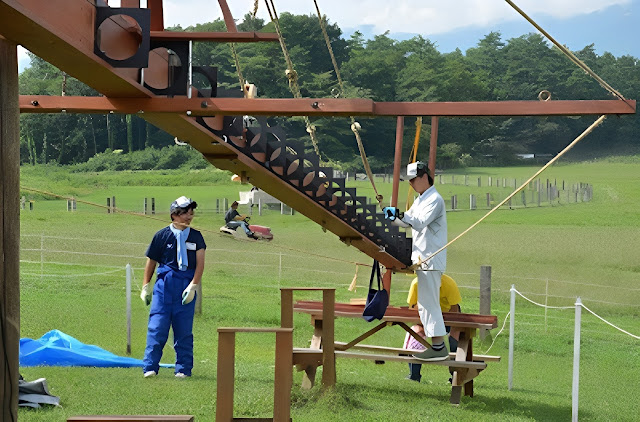Japan Hevelius Telescope replica 21m 150mm diameter
Replica telescopul Hevelius de 21m diametrul 15cm din Japonia
Unică printre ele este crearea în 1673 a unui telescop Keplerian gigantic cunoscut sub numele de „telescopul aerian al lui Hevelius”. În 1609, Galileo a folosit un telescop refractor cu o lentilă pentru a observa luna. A fost dificil la vremea respectiva să faci un telescop cu cu o putere mare de marire.
Cel mai simplu mod de a reduce aberațiile cromatice este reducerea curburii lentilei, dar aceasta mărește distanța focală. Pentru a menține aberația cromatică la același nivel atunci când diametrul este dublat, este necesară o distanță focală de patru ori mai mare.) Ca urmare, telescopul lui Hevelius se pare ca a avut diametru cuprins intre 15 si 20 centimetri și o lungime de 45 de metri. Telescopul aerian și-a primit numele de la faptul că nu avea un tub din cilindru. De fapt, era prea mare pentru a fi manevrabil, și a fost afectat chiar și de cel mai mai mic vânt, se pare ca nu au fost posibile observații satisfăcătoare prin el.
Cel mai simplu mod de a reduce aberațiile cromatice este reducerea curburii lentilei, dar aceasta mărește distanța focală. Pentru a menține aberația cromatică la același nivel atunci când diametrul este dublat, este necesară o distanță focală de patru ori mai mare.) Ca urmare, telescopul lui Hevelius se pare ca a avut diametru cuprins intre 15 si 20 centimetri și o lungime de 45 de metri. Telescopul aerian și-a primit numele de la faptul că nu avea un tub din cilindru. De fapt, era prea mare pentru a fi manevrabil, și a fost afectat chiar și de cel mai mai mic vânt, se pare ca nu au fost posibile observații satisfăcătoare prin el.
Acest telescop Hevelian a fost creat de Kubota Kogaku în Iwate (http://www.rnac.ne.jp/~uccc/makiba.htm) și instalat la Koiwai Farm. Koiwai are trei telescoape aeriene în total, dintre care cel mai mare are 21 de metri lungime diametrul de 15cm obiectiv dintr-o singura lentila plan comnvexa. Sunt foarte interesat de ce fel de imagini ale lunii produc vechile telescoape cu o singura lentilă de focala lungă, în comparație cu telescoapele apocromatice moderne cu focalizare scurtă.
Domnul Mao profesor de științe de liceu (60 de ani) a făcut acest lucru pe cont propriu bazându-se doar pe un tablou care a fost în literatură datând de vreo 350 de ani. Primarul invită participarea la „Experimentează un moment de vis interesant atât pentru copii, cât și pentru adulți”.
Telescoapele aeriene nu sunt un telescop obișnuit ele sunt defapt prima varianta a unui telescop truss format din mai multe scanduri groase conectate intre ele, lumina de la obiectiv trece prin mai multe diafragme montate pe toata lungimea telescopului acest lucru este conceput pentru a reduce din greutate acest telescop Hevelian este cel mai lung din lume, se numeste aerial pentru ca nu este un telescop cu tub inchis, cu el pt fi văzute cratere magnifice pe Lună.
Domnul Saito era interesat de stele pentru că tatăl său l-a făcut o lunetă când era elev la școală elementară. Și-a înființat propriul departament de astronomie când era la Universitatea de Inginerie Iwate. După absolvire, a lucrat ca profesor de științe și director la o școală gimnazială din prefectura Iwate timp de 22 de ani și s-a reangajat ca instructor de natură la o fermă mică, când avea 45 de ani.
În 2003, când a devenit director al departamentului astronomic, a lucrat la producția de telescoape aeriene. Nu existau schițe, singurele indicii erau ilustrațiile din literatura europeană de acum 350 de ani.
Printr-un prieten de la universitate, producatorul de lentile Kubota Optics (Hanazawa City) ia oferit gratuit lentile obiectiv, iar la centrul de domiciliu am obtinut placi si feronerie. Primul instrument a avut 10 metri lungime, a fost finalizat în 2005 după doi ani, dar provocarea a fost că lentilele de diferite dimensiuni de pe plăcile care leagă cele două lentile nu s-au lipit și focalizarea nu a fost corectă.
Doi ani mai târziu, telescopul Hevelian de 21 de metri a fost finalizat folosind un obiectiv plan convex de 15 cm în diametru realizat de compania Kubota Optics. Doamna Kanna avea 53 de ani când visul ei de la școala primară s-a împlinit.
Telescopul este folosit din 2007 primarul spune: „Vreau să simt romantismul de a privi stelele printr-un telescop aproape identic cu cel folosit acum 350 de ani.
ENGLISH
Hevelius telescope replica in Japan 21m 150mm aperture
Unique among them is the creation in 1673 of a giant Keplerian telescope known as "Hevelius' replica telescope". In 1609, Galileo used a refracting telescope with a lens to observe the moon. It was difficult at that time to make a telescope with a high magnification power.
The easiest way to reduce chromatic aberration is to reduce the curvature of the lens, but this increases the focal length. To keep the chromatic aberration at the same level when the diameter is doubled, four times the focal length is required.) As a result, Hevelius telescope had maybe 15 or 20 centimeters in diameter and 45 meters long. The aerial telescope got its name from the fact that it did not have a cylinder tube, in fact, it was too large to be manoeuvrable, and was affected by even the slightest wind, so apparently no satisfactory observations were possible.
Now this Hevelian telescope replica was created by Kubota Kogaku in Iwate (http://www.rnac.ne.jp/~uccc/makiba.htm) and installed at Koiwai Farm. Koiwai has three aerial telescopes in total, the largest of which is 21 meters long, 15cm diameter objective from a single plano convex lens. I am very interested in what kind of images of the moon the old long focal length single lens telescopes produce compared to modern short focal apochromatic telescopes.
Mr. Mao high school science teacher (60 years old) did this on his own based only on a painting that has been in literature dating back some 350 years. The Mayor invites participation to "Experience an exciting dream moment for both children and adults".
Aerial telescopes are not an ordinary telescope they are actually the first version of a truss telescope consisting of several thick planks connected together, the light from the objective passes through several diaphragms mounted along the entire length of the telescope this is designed to reduce the weight, this Hevelian telescope is the longest in the world, it is called aerial because it is not a telescope with a closed tube, with which you can see magnificent craters on the Moon.
Mr. Saito was interested in the stars because his father made him a spotting scope when he was a student in elementary school. He established his own astronomy department when he was at Iwate University of Engineering. After graduation, he worked as a science teacher and principal at a middle school in Iwate Prefecture for 22 years, and re-employed as a nature instructor on a small farm when he was 45.
In 2003, when he became director of the astronomy department, he worked on the production of aerial telescopes. There were no sketches, the only clues were illustrations from European literature from 350 years ago.
Through a friend from the university, the lens manufacturer Kubota Optics (Hanazawa City) offered him objective lenses for free, and at the home center I obtained plates and hardware. The first instrument was 10 meters long, it was completed in 2005 after two years, but the challenge was that the lenses of different sizes on the plates connecting the two lenses did not stick and the focus was not correct.
Two years later, the 21-meter Hevelian telescope was completed using a 15 cm diameter plano-convex objective made by Kubota Optics. Ms Kanna was 53 when her primary school dream came true.
The telescope is used since 2007. It is harder to see than a regular telescope, but the mayor says, “I want to feel the romance of looking at the stars through a telescope almost identical to the one people used 350 years ago.
Images of the Hevelian telescope:
 |
| Eyepiece single lens element (ocularul constitutit dintr-o singura lentila) |
 |
| Objective lens 15cm diameter ( lentila obiectiv 15cm diam) |
Assembly:
THE MOON:
Alte telescopae de tip Hevelius































































Comentarii
Trimiteți un comentariu